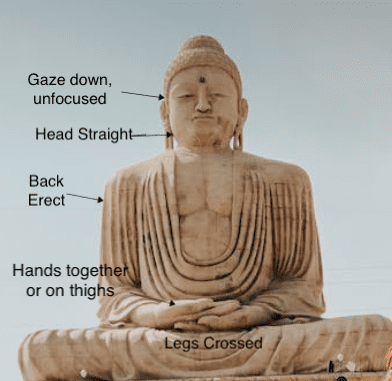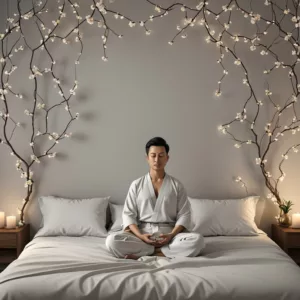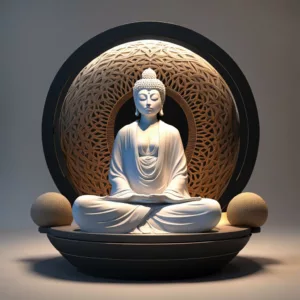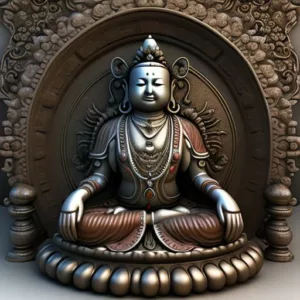The best meditation posture is Marpa’s seven-point posture of meditation. On a cushion: cross legs, hands on thighs, straight back, erect neck, unfocused gaze slightly forward, and mouth slightly open.
Table of Contents
Correct Position for Meditation
note: this is not the only correct posture, but it is widely considered the best.
| 7-Point Posture | Variants | Benefit |
| Ankles Crossed | Lotus, half-lotus, chair | Energy circulates, balance |
| Hands on thighs | Cosmic Mudra | Opennes Variant – Gathers Mind at Hara |
| Back Erect | None | Straightens Channels for Prana Flow |
| Head Erect and straight not jutting forward | Slightly tucked | Extends Channels, loosens knots, promotes focus |
| Gaze slightly down Unfocused | Many – straight ahead, fixed, slightly up | Controls the mind, tightens focus, opens perceptions, and more |
| Mouth – lips pursed | Closed | Mixed nose and mouth breath tames emotions |
| Tongue tip on back of upper teeth | Held in space | Generates mental focus Variant signifies emptiness |
Meditation Sitting Positions

Sit comfortably with legs crossed. Legs can either be crossed at the ankles or one leg on top of the other in half vajra/lotus. Generally, however, crossed legs are fine. This has the effect of creating a circular flow of the bodily energies. The loop is connected.
To place the hands properly, let the arms hang straight down from the sides, then lift the forearms and place the hands relaxed on the thighs right where they land. This creates a sense of openness and ease in the posture since relaxation. Alternatively, the hands can be placed together in the lap with the thumbs knocked together. Or with the hands placed together, the thumbs touching and the cosmic or egg mudra. This posture can help focus and gather the mind. The hands held together as a jewel can be seen to represent the jewel of mind.
Vajra Posture

You can be in full vajra posture with both ankles crossed up across the opposite knee. This is generally too uncomfortable for most westerners, not having done it as a child to adapt the body to it. However, there are methods to increase this both through breathing and through yoga.
Vajra posture is extremely powerful for meditation. The loop of energy is closed and brings everything back through the body. Energy does not leak. Thus it can be well controlled. It becomes stable and useful. If your body is suitable for this posture, I recommend it in brief periods. These can be lengthened gradually.
Meditation posture Meaning
Symbolic aspects of meditation are important and can become extremely potent as an aid to meditation.
| Crossed legs | Infinity |
| Hands on thighs Cosmic Mudra | Openness Singularity / Oneness |
| Back Erect | Strength / Stability |
| Head Erect, not jutting forward | Balance |
| Chin tucked | Self-contained |
| Gaze down OR- | Controlled mind, tight focus |
| Gaze ahead | Seeing Wisdom |
| Gaze unfocused | Not grasping at samsara Looking inward |
| Mouth slightly open, both breathing | Releasing emotions Mixing mind and space |
| Tip of Tongue up, touching nothing | Inseparability of samsara and nirvana |
Meditation Posture for Beginners
The back should be straight. There is a slight natural S-curve to the back as the lower back goes towards the front of your body.
- Do not slouch
- Don’t lean forward at all
- Don’t hold the back rigid
- Don’t lift the shoulders – intentionally relax them
This posture helps to find the balance between too tight and too loose. If you’re too rigid, trying to hold the body erect, the shoulders will tend to hunch up. This makes the body too tight. It will create excess mental activity and long-term discomfort. As a result, meditation will become disagreeable. You won’t accomplish very strong meditation. You’ll have trouble getting past the fourth stage of meditation.
Occasionally when you’re meditating, remember to straighten your body. Maybe give the shoulders a couple of rolls to loosen them up. Relax the shoulders and drop them down. The head should not be jutting forward. It should be placed directly above the spine, then relax the neck.
In the West, we have a tendency to push the head forward. As a practice, it’s good to slightly tuck the chin in. This tends to correct that screen-looking tendency that so many of us have. Just a bit to the point where it has only the slightest degree of discomfort. This tucking is actually part of the traditional instruction. It helps to slightly lengthen the spine. A slightly lengthened spine helps open and untie the nadis allowing the prana (energy) to flow.
Is it better to breathe through your nose or mouth meditation?
During meditation, it is better to breathe through both nose and mouth at the same time. Nasal breathing is far healthier in general, but bringing a small amount of air through pursed lips simultaneously can settle the emotions.
The mouth is slightly open. There’s supposed to be an even balance breathing in through the mouth and the nose. It’s just a tiny bit of air coming through the mouth along with mostly air coming through the nose. This is difficult and it feels weird and foreign, so don’t make too big of a deal about this one, especially in the beginning.
Once you’ve stabilized the other factors of posture, then maybe experiment with this somewhat. But it’s not particularly recommended in the beginning. Most of the meditators I know don’t use this. I don’t myself. However, I mention it to be thorough. One modification of this is to hold the tip of the tongue just against the back of the upper teeth. This feels very strange, but I’ve meditated with this occasionally and it does something. It’s hard to describe. If you feel like it, give it a try and see if it works. And let me find the other points of meditative posture.
Eyes
The next point is the eyes. There are good reasons for open eyes meditation. There are many gazes which can be done in meditation. Generally for beginners, the recommended gaze is about six feet in front of the meditator.
Buddhist Meditation Posture
The Buddhist Meditation Position is typically the 7-point posture, though it can be modified to full or half lotus. The three components of the so-called Vajra body or the immaterial body are Prana, Nadi and Bindu. The nadis are the channels along which the prana, the energy of the mind flows. The nadis are considered to be knotted up or tied up. This restricts the flow of energy.
Sitting still and holding the body in proper posture helps to unwind the nadis. Then the energy flows properly in the right places in the body. It brings a profound sense of relaxation and ease. The mind focuses effortlessly.
The bindu is the faculty of the mind to concentrate, to focus one-pointedly. It’s the conscious element of the mind as opposed to the subconscious element – in western terms. Bindu can be distributed. You can have a generalized awareness of things as well.
When the body is still and erect in the proper posture, the nadis are lengthened not twisted or bent to one side, the prana will slow down and will move towards the central channels of the body as it were. This makes the body feel smoother and stiller. The mind moves less in this lowered activity.
Best Meditation Position
Although numerous meditation postures exist, the 7 point posture of Vairochana (or Marpa) is considered the best one. It combines the best elements of meditation – relaxing the body in stability, opening the channels, and settling the mind. The posture is generally comfortable, after a ‘breaking-in’ period.
Meditation position Benefits
The correct posture in meditation creates psychophysical benefits. The body must be aligned properly to meditate well. When the body is aligned properly, it lines up the “nadis,” non-material channels that allow energy to flow through the psychophysical body. This alignment puts the mind in a clear and easy state.
Thoughts and emotions naturally subside. Focus becomes much easier. In short, mind follows the body. A well placed body generates a stable, positive mind.
The limiting of thoughts is highly conducive to meditation. If this, and it is one aspect of it generally, when the mind slows down from constantly thinking about various things, it can be harnessed. The power and ability of the mind can be harnessed to generate good meditation or to generate meditation.
T
The 7 point posture aligns the channels, allowing the pranic energy to move easily. This settles the mind, making it workable.
The 7 point posture is the most profound instruction
Marpa Lotsawa
Once the prana flows freely, the bindu of the mind, the concentrated faculty of the mind can be controlled. You can do what you want with it. This ability to control your own mind is one of the greatest features, one of the most pleasing and amazing experiences in meditation. In some sense, it’s the heart of meditation.
Meditation Sitting Position Hurts
Proper Meditation Posture pdf
If your meditation sitting posture hurts, then try the following steps:
- Guage the pain – 1-10 scale
- Below 4-5, you might try to work with it for a while. Sometimes it will stop as the body adjusts
- Above 5, try sitting in a chair or decreasing the period
- Print the Correct Meditation Posture chart pdf above and reference it while sitting
- Memorize the key points and refresh the posture periodically
- Do yoga for the appropriate body parts (knees, etc).
- Time limit the meditation, letting the body adjust over several weeks
- Use the resting posture, knees up, wrapped by arms, head erect
- Master the breathing and direct the breath, or prana, to the affected parts
- Do not push past the point of possible damage
Burmese Meditation Posture

The Burmese posture is a variant with the legs not crossed, but both ankles resting on the ground.
Meditating Lying Down
Can you meditate lying down? Is it possible to meditate in other postures, etc.? You can meditate while lying down, but it’s very difficult for a beginner to do so. The mind tends to wander off easily. However, this only means that it’s probably better to sit up for formal meditation. When you are in bed – definitely work with meditation. It’s great way to deal with insomnia. And you want to be able to meditate in any position, ideally.
The yoga posture Shavasana is probably the most conducive. It can be modified to stack the hands on the belly.

Also, the right side posture of the Buddha as he passed is recommended for sleeping.
M
faq
What is the proper position for meditation?
The proper position for meditation is the 7-point posture.
Ankles Crossed
Hands on thighs
Back Erect
Head Erect and straight
Gaze slightly down
Mouth – lips pursed
Tongue tip on back of upper teeth
How to sit in meditation posture for long hours
To sit in meditation posture for long hours, use the correct meditation posture. Marpa’s 7 point posture is the definitive Buddhist meditation posture.
Why sit cross legged during meditation?
Sitting cross-legged during meditation creates a circular flow to the energy. No leaks. This increases mental focus, clarity, and settles the mind without heaviness.
What happens if you can’t sit in lotus position?
If you can’t sit in Lotus position, you can still meditate just fine. Probably better because it won’t hurt. Just use the cross-legged posture above.
What is the Burmese posture for meditation?
The Burmese posture is the same as the Buddhist Meditation Posture except the legs are laid one inside the other instead of crossed.
What is the Japanese pose for meditation?
The typical Japanes Pose for meditataion is Seiza, a kneeling posture.
How do I sit in Meditation without Pain?
To sit in meditation without pain, try the Buddhist Meditation Posture. See above to download the Correct Meditation Posture pdf and keep it at your meditation area.
What is the posture for Buddhist meditation?
The Posture for Buddhist Meditation is the 7-point posture of Marpa. See the following after the faqs to download a pdf of the best meditation posture.








